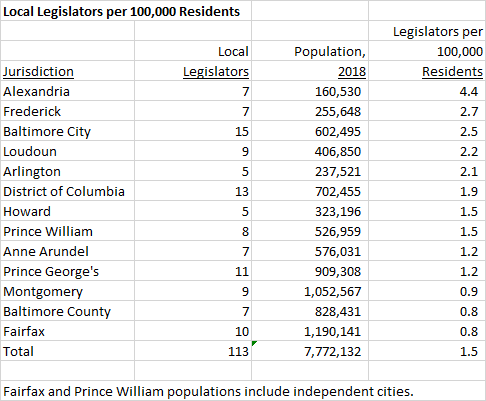By Adam Pagnucco.
Abolishing at-large county council seats is a really bad idea because it would eliminate most political competition in county elections. However, adding council district seats is justified. Relative to other large jurisdictions in the area, MoCo has few local legislators per capita and huge districts.
The table below shows the number of local legislators (city and county council members, supervisors and board members) per 100,000 residents for 13 major jurisdictions in the area. Elected officials of municipal governments inside those jurisdictions (like the city governments of Rockville and Gaithersburg) are not included.

Large jurisdictions in the region have an average of 1.5 local legislators per 100,000 residents. At 0.9, MoCo is on the lower end of this distribution. If MoCo were to have the regional average number of local legislators per capita, it would have a 15-member county council.
The table below shows the number of residents per local district. Two jurisdictions (Alexandria and Arlington) do not have districts as all local legislators are elected at-large. Three others (Anne Arundel, Baltimore County and Howard) have all district-based legislators. The others in the table have a mix of district and at-large members. Prince George’s County once had 9 district-based council members, but in 2016, residents approved Question D to add 2 at-large members by a 67-33% vote.

With over 210,000 residents per local legislative district, MoCo’s districts have more than twice the number of people as the regional average. Let’s bear in mind that council members typically have just the equivalent of 4 full-time staff members each. District council offices, which are the primary points of contact for constituent services, can easily get swamped by service requests during busy times. (When I worked at the council years ago, District 1 would easily generate the most constituent contacts, especially when there were power outages!) If MoCo were to emulate the regional average, the county would have 10 council districts.
And so if there is to be a structural change to the county council, it should not be abolishing at-large seats – a change that would eliminate most political competition for council. Rather, the at-large seats should be kept and the number of districts should be expanded. Such a system would be more expensive for taxpayers because it would add politicians and staff. But it might increase responsiveness to constituents and it would preserve electoral competition, two big benefits for MoCo residents.



